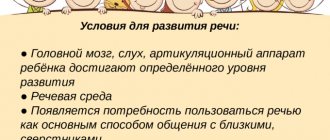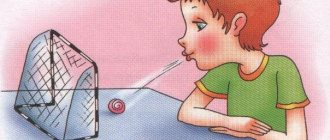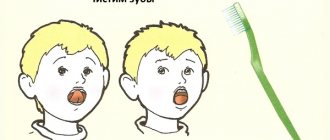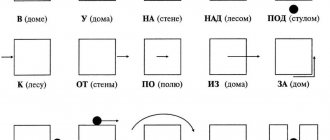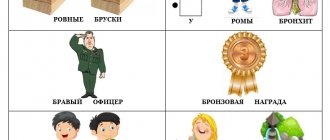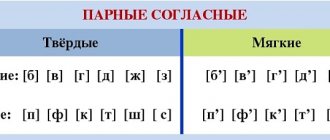Methodological development for sound automation
The prevalence of speech disorders among preschool children is so high that the opening of speech therapy centers for children with incorrect pronunciation of sounds in preschool educational institutions is very important. This approach makes it possible to reach a significant number of children with various speech disorders with speech therapy assistance.
Since the main goal of speech therapy work is the correction of sound pronunciation (production, automation, differentiation of sounds), we propose to consider the features of the content of the stages of speech therapy classes on sound automation.
Automation of the given sounds takes quite a long time, since the child must quickly and correctly find the articulatory structure of the sound being practiced. Learn to clearly articulate it in speech structures of varying complexity, in the following sequence: in syllables, in words, in phrases, in connected speech, in spontaneous speech.
Automation of sounds occurs in parallel with the development of phonemic awareness skills. When analyzing, synthesizing and selecting words or pictures, all speech material from the previous stage is used, all sounds introduced into the speech of preschoolers are used
Speech material on the automation of sounds is taken into account when selecting a lexicon and when children master the grammatical patterns of their native language.
At the stage of formation of communicative pronunciation skills and abilities, the child develops the ability to update all pronunciation skills and knowledge acquired earlier. Memorizing poems on certain lexical topics is of great importance. These texts must include all speech sounds taught in speech therapy classes.
As M.E. Khvattsev wrote: “When automating sounds through long-term and varied training in coherent speech, a strong connection is established in the cerebral cortex between certain points of stimulation. Then sound reflexes can be maintained for a month for a number of years without further training and reinforcement.”
At the same time, children’s pronunciation skills are practiced in various dramatizations, performances, and during musical and sports events. Therefore, the relationship in the work of a speech therapist and other kindergarten teachers (teacher, music director and physical education teacher) becomes important.
For normal sound pronunciation, it is not enough for a child to master the system of phonemes of the language, phonemic perception and have sufficient mobility of the organs of the articulatory apparatus. He needs to use phonemes taking into account different phonetic conditions.
When selecting linguistic material for the correction of sound pronunciation disorders, it is necessary to take into account the diverse non-linguistic and, above all, linguistic context .
The phonetic (linguistic) context refers to the phonetic conditions for the implementation of a certain segment, namely:
- The position of the sound in a word (its absolute beginning, end or middle;
- Finding it in a “strong” or “weak” position in a word;
- In the vicinity of certain sounds (place and row of formation);
- In a certain type of syllable (for example: SG, GS, SSG, etc.);
- In words "long" or "short".
In the process of automating newly formed sounds in children, it is proposed to start with the structure of syllables of the SG type. And then move on to the vowel-consonant structure (VC). In a number of cases (for example, when forming the sounds [l], [ts], [p], [рь]), it is allowed to introduce the sound first into the syllable of the GS structure.
A particular difficulty for a child is the correct pronunciation of consonant clusters. Therefore, the sound being formed is lastly processed in the most frequent variants of combinations of consonant sounds.
It is recommended to move from fixing the sound in syllables to practicing it in words.
The order of sound automation in words
The sequence proposed above for introducing a newly formed sound into various types of syllables allows us to adhere to the following order of sound automation in words:
- At the beginning of the word
- At the end of a word (if the consonant is voiceless),
- In the middle of a word
- In words with a combination of consonants.
In some cases, the sounds [р], [рь] are not formed in the sequence “at the beginning of the word”. "at the end". “in the middle”, but vice versa, since these fricatives (and at the end of words they are fricative) are often learned better than tremors. From fricatives [р], [рь] they successfully move on to pronouncing their main – tremulous variants.
In words, syllables of the SG type (like other types of syllables) are processed primarily in a strong position, that is, the sound being formed is under stress, and the consonant is before the stressed vowel, since in this position a greater number of phonemic oppositions are realized (the further the syllable from stress, the more it is reduced).
The structure of a speech therapy lesson at the stage of sound automation
In connection with the above, we propose the following structure of a speech therapy lesson at the stage of sound automation:
Topic: Sound...
Lesson objectives:
Equipment:
Progress of the lesson
- Organizing time.
- Articulation gymnastics.
- Announcing the topic of the lesson.
- Pronunciation of an isolated sound (choral, group, chain, individual).
- Analysis of articulation according to plan.
- Characteristics of sound.
- The connection between sound and letter.
- Development of phonemic hearing.
- Fixing sounds in syllables. Sound analysis and synthesis of syllables, graphic recording.
- Consolidating sounds in words. Sound analysis of words with graphic recording.
- Fixing a sound in a sentence. His graphical analysis.
- Fixing sound in text.
- Homework.
- Results of the lesson.
- Assessment of children's work.
Depending on the stage of automation, sound can be varied by the structural elements of the proposed lesson plan. It must be remembered that classes should be exciting: they should be thematic, with the presence of surprises, filled with various colorful visual and didactic material. And don’t forget about play, because play is the leading activity of a preschool child.
Let us give an example of a speech therapy lesson that corresponds to the proposed structure.
Topic: Sound automation [p].
Objectives of the lesson: to consolidate the clear pronunciation of the sound [r] and the ability to characterize the sound, to develop phonemic processes, fine motor skills, and memory.
Equipment: envelopes, drawing “Apple Tree”, object pictures, cut-out alphabet, diagrams of words and sentences, diagram of the articulatory structure of the sound [p], paper clips, task cards.
Progress of the lesson
1. Today you and I will have guests, but to find out who they are, you and I must solve riddles. I’ll tell you riddles, and you try to guess them; if you don’t succeed, I’ll tell you:
Chick - tweet! Jump to the grain, Peck, don’t be shy. I live in the yard, This is... (sparrow)
Spinning, chirping, busy all day. (magpie)
Coloring - grayish Habit - furtive, Screamer hoarse. Famous person. Who is she? (crow)
Yes, a sparrow, a crow and a magpie came to visit us. Repeat again loudly and beautifully the names of these birds.
What same sound do you hear in the names of these birds? Right! Today we will repeat the sound [r]. Pronounce this sound correctly and beautifully.
Let's play with our tongue, and our guests will repeat after us.
Exercises: “Mushroom”, “Horse”, “Coachman”, “Chatterer”.
When we pronounce the sound [r], in what position are our lips, teeth, and tongue?
Is the sound [r] vowel or consonant, hard or soft, voiceless or voiced?
Make the letter P from paper clips.
2. The birds came to play with us and brought us some envelopes, but when they sat on the tree they lost their envelopes. Let's help each bird get to its envelope. Which bird will you help get to the envelope first? The sparrow will jump from apple to apple, and you will pronounce the syllables:
Ra - ra - ra ro-ro-ra Ro - ra - ro ro-ro-ro
And so with every bird.
3. Look at the color of the envelope the sparrow brought us? (brown). What about magpie? (orange). And the crow? (multi-colored)
4. Let's see what the birds brought us in envelopes. Let's take the sparrow's envelope: what is there? (Pictures). Take out one picture at a time and name them.
Choose any five pictures and arrange them in a line. Tell me which pictures you chose? Look at the pictures again and try to remember them. The game "What's missing?"
And the sparrow also brought us a “pyramid”: on the top step of the pyramid put pictures with three sounds in their names; on the second step - pictures of four sounds; On the bottom step place pictures with five sounds in their names.
5. Let's see what the crow brought us. Game "Word Chain". Choose any word from those suggested by the crow and make it out of letters. Make a diagram for it.
6. Magpie invites us to show her how beautifully you can pronounce the sound [r]. Listen carefully and repeat after me:
Ra-ra-ra, ra-ra-ra - the mouse’s home is a hole. Ro-ro-ro, ro-ro-ro - the nut has a kernel. Ra-ra-ra, ra-ra-ra - smoke
7. Our white-sided girl also wants you to teach her to speak competently. While she was flying towards us, she dropped her envelope containing the proposals. The words in this sentence are jumbled. Let's help the magpie put all the words in their places:
Cancer, in, lives, sea. Vase, rose, standing, in. The bull has horns.
Choose any sentence and make a diagram for it.
8. And here is a card where the words in the sentences are also mixed up. Work with them at home.
9. Remember what sound we repeated today? Where is the tongue when we pronounce this sound? Is your throat working?
10. Our guests enjoyed working with you. Did you like their assignments? What was the most difficult thing?
You tried hard today. Let's say thank you to our guests. We are waiting for them to visit us again.
Shklyaeva Ekaterina Ivanovna, teacher-speech therapist, MBDOU No. 37, Achinsk
- Presentation [Syllable tables for sound automation]
- Methodological development of a lesson in the first grade for a group of students with FFND. Topic: B-B sounds
- Speech therapy games for automation and differentiation of sounds
- Individual lesson on sound automation [L] in syllables, words, phrases, connected text [Differentiation of sounds L – R]
- Methodological development with presentation: Speech therapy holiday “Journey to the Land of Correct Speech”
( 3 liked, average score: 5.00 out of 5)
Loading...
Sequence of work on sounds
G.V. Chirkina points out that the sequence of work on sounds is determined by the following factors:
1) the degree of accessibility of sounds for pronunciation and the gradual transition from lesser to greater pronunciation difficulties;
2) articulatory and acoustic proximity of sounds;
3) the possibility of selecting speech material, including sounds.
1) The degree of accessibility of sounds depends not only on the ease of articulation, but also on the possibility of visual perception of individual elements of articulation and the presence of an “oral image of sound.” The following sounds are considered to have visible articulation: a, o, y, e, i, p, b, m, f, v, w, g, l, s, t, k (according to the degree of decrease in the visible elements of articulation).
In terms of ease of articulation, vowel sounds are considered to be the simplest, and among them – [a], which is formed by moving forward the tongue pressed to the bottom of the oral cavity. Plosive consonants are easier to learn than fricatives. The lightest plosive sound is [p], and [f], [v], [x] are the lightest among fricatives.
2) Sound acquisition becomes more difficult if its articulation or acoustic characteristics are close to the articulation or acoustic properties of a previously acquired sound. In this regard, the production of sounds that are close in articulatory and acoustic characteristics should be dispersed in time.
3) The possibility of selecting a sufficient amount of available speech material explains the situation when sounds that are more difficult to articulate are studied first: for example, the sound [s] is earlier than the sound [e], while [e] is easier.
Features of sound production
1) The main methods of correcting sound pronunciation are: motor-kinesthetic and auditory-visual-kinesthetic (E.M. Mastyukova, M.V. Ippolitova).
2) The most common method of producing sounds for dysarthria is the method of phonetic localization, when an “analogue” of a sound is called, which does not completely coincide in its acoustic and articulatory characteristics with the standard of correct speech, but at the same time is clearly opposed to all other speech sounds. For a child with dysarthria, approximate pronunciation of a sound is a certain step towards mastering normative articulation. Mastery of a sound analogue is sufficient for the child to be able to operate with it while working on the development of phonemic concepts and sound analysis skills (G.V. Chirkina).
3) Significantly longer periods of work on each sound (O.V. Pravdina).
4) The need to simultaneously work on several sounds belonging to different articulatory groups (O.V. Pravdina).
5) Reliance on the child’s compensatory capabilities (safe analyzers, correctly pronounced sounds, involuntary movements, sound combinations).
6) Maintaining a certain sequence in working on sounds.
7) Taking into account the influence of pathologically enhanced postural reflexes on sound pronunciation and its prevention with the help of special exercises in reflex inhibiting positions.
 Correction of sound pronunciation for dysarthria is usually combined with work on improving the intonation expressiveness of speech (L.V. Lopatina, N.V. Serebryakova).
Correction of sound pronunciation for dysarthria is usually combined with work on improving the intonation expressiveness of speech (L.V. Lopatina, N.V. Serebryakova).
EAT. Mastyukova and M.V. Ippolitova emphasize that the main task in working on speech correction for dysarthria is the development of speech communication, therefore work on sound pronunciation should always facilitate, not complicate it.
Breathing correction technology for dysarthria
EAT. Mastyukova and M.V. Ippolitov identifies the following stages of working on breathing with dysarthria.
Stage one: general breathing exercises
Goal: increase breathing volume and normalize its rhythm.
Exercise 1. The child lies on his back. The speech therapist bends his legs at the knee joints and presses on the armpits with bent legs. These movements are performed in normal breathing - ri - bending the legs, "two" - pressing them on the armpits, "three" - returning the legs to their original position. This exercise helps normalize the movements of the diaphragm.
Exercise 2. The child sits with his mouth closed. Then one nostril is closed. The child breathes to a certain rhythm (counting or the beat of a metronome). Then the child's second nostril is closed. The same cycle of breathing movements is repeated.
Exercise 3. The child is sitting. A “fan of air” is created in front of his nostrils. Under the influence of this air, the depth of inhalation increases.
Simultaneously with general breathing exercises, it is very important to teach children how to blow their nose correctly. Mastery of this skill contributes to the formation of an extended voluntary exhalation. To consolidate this function, it is necessary to rely as much as possible on sensations.
Basic rules of breathing exercises:
1. You cannot overtire your child.
2. It is necessary to ensure that he does not strain his shoulders, neck or take an incorrect position.
3. The child’s attention should be focused on the sensations from the movements of the diaphragm, intercostal muscles and muscles of the lower abdomen.
4. The child should perform all breathing movements smoothly, to the count or to music.
5. Breathing exercises should be carried out before meals, in a well-ventilated area.
Stage two: speech breathing exercises
Exercise 1. The speech therapist closes the child’s nostrils and asks him to inhale through his mouth until he asks him to pronounce individual vowel sounds or syllables.
Exercise 2. The child is asked to inhale through his mouth. The speech therapist places his hands on the child’s chest, as if preventing him from inhaling for 1 to 2 seconds. This promotes deeper and faster inhalation and longer exhalation.
Exercise 3. The child is asked to hold his breath as long as possible, achieving a slower and deeper inhalation, followed by a slow and prolonged exhalation.
It is recommended to carry out such exercises daily for 5–10 minutes. During these exercises, as the child exhales air, the speech therapist pronounces various vowel sounds. At the same time, he varies the volume and tone of his voice. Then he asks the child to imitate him and encourages him to pronounce fricative consonants in isolation and in combination with vowels, plosive consonants and other sounds.
Thus, the child is taught to breathe through the mouth, inhale and exhale through the nose, inhale through the nose and exhale voluntarily through the mouth.
Speech breathing is developed in different positions of the child: lying on his back, sitting, standing. In case of severe motor damage, breathing exercises are carried out in reflex prohibiting positions.
In the process of practicing speech breathing, special exercises and games are of great importance: blowing soap bubbles, blowing out candles, blowing small fluff and pieces of paper off the table, playing the harmonica, various pipes, blowing into special paper tubes.
Games are selected differentially depending on age and the nature of the breathing disorder.
Work on breathing, phonation and articulation is carried out in close unity; Special logorhythmic exercises and games are of great importance in this work.
In these classes, exercises for the development of general and articulatory motor skills, breathing and voice are carried out to musical accompaniment.
Many observations suggest that music promotes general and local muscle relaxation, a reduction in violent movements, coordination and coordination of movements. Therefore, a number of movements that are inaccessible to a child in a normal environment can be performed by him to musical accompaniment.
Thus, work on the formation of speech breathing in dysarthria is carried out in stages, taking into account disturbances in the innervation of the muscles of the speech apparatus and the degree of motor defect in cerebral palsy, and also develops the coordinating relationship between breathing, voice and articulation.
G.V. Dedyukhina suggests using the V.F. apparatus in the correction of breathing disorders due to dysarthria. Frolova.
Methods of making sounds for preschool children
Nina Deltsova
Methods of making sounds for preschool children
METHODOLOGY FOR PRODUCING SOUNDS FOR PRESCHOOL CHILDREN.
Deltsova Nina Mikhailovna
teacher-speech therapist MBDOU "D/s "Olenenok"
According to the Federal State Educational Standards, the content of the educational field “Speech Development”
is aimed at achieving the goals of developing oral speech and verbal communication skills with others based on proficiency in the literary language of its people.
The speech development of a preschooler in accordance with the Federal State for preschool education includes mastery of speech as a means of communication and culture; enrichment of the active vocabulary; development of coherent, grammatically correct dialogical and monologue speech; development of speech creativity; development of sound and intonation culture of speech, phonemic hearing; acquaintance with book culture, children's literature, listening comprehension of texts of various genres of children's literature; formation of sound analytical-synthetic activity as a prerequisite for learning to read and write.
Speech is a necessary basis for human thinking; thought processes develop and improve as the child masters speech. On the other hand, the process of gradual mastery of speech is one of the main indicators of the normal mental, and partly, physical development of the child.
Speech impairment can occur at any age , but speech is most vulnerable in children . The vulnerability of children's speech is due to the fact that speech that takes a long time to develop is one of the most complex human skills.
The earlier a difficulty arises, the more significant it turns out to be for further speech development. If a child’s speech lags significantly behind the age norm , then comprehensive correctional work is necessary. When planning rehabilitation work with a child, it is necessary to take into account his mental and physical qualities in order to successfully master the correct sound pronunciation , as well as the analysis and synthesis of the sound composition of a word .
children who need speech therapy help are selected Before starting correctional work, it is necessary to meet the parents, talk about the early development of the child (What was the birth like? When did he cry? The first speech sounds ? Etc.). This data is necessary for further work with the child.
Those children who need speech therapy help are tested for normal physical hearing, the state of the articulatory apparatus and the state of phonemic hearing.
Having identified all the shortcomings, I begin corrective classes. When teaching, it is necessary to take into account the individual speech abilities of each child; create favorable conditions for more successful learning of the material (colorful visual aids, affectionate background, obligatory praise of the child).
We begin the work with articulation and finger gymnastics; preparing the speech apparatus for producing sounds , we carry out bioenergoplasty (coordination of words and movements, which is an effective means of speech and mental development. Articulatory gymnastics is better done in poetry, it will be more interesting, children really like it, and, which allows children to better assimilate and repeat exercises.
At first, you need to take the simplest exercises so that they are easier to obtain and produce results, so that the child is interested in success, which is very important for further work. Next, we move from easy to difficult. It is necessary to take into account everyone’s capabilities and approach them individually. As a result of the work done, the speech apparatus is ready to produce sounds . We start with whistling sounds ( "s"
,
"s'"
,
"z"
,
"z'" "c"
,
"c'"
).
We put on sound , automate, differentiate, introduce into speech.
When introducing into speech, we use syllables (direct and reverse, words, sentences, nursery rhymes, pure sayings and short poems. Whistling sounds are well-mannered, when pronouncing whistling sounds, the child holds his tongue well behind the lower incisors, keeps his lips in a slight smile. Next, we move on to hissing sounds ( “sh »
,
“zh”
,
“ch”
,
“sch”
, we completely change the position of the tongue.
Articulatory gymnastics changes completely; the tongue must be held at the top. The work begins with the education of the sound “sh”
, and then, step by step, we move on to each missing
sound , as they are clearly pronounced. Then we move on to the differentiation of educated whistling and hissing sounds . The work on the whistling and hissing sounds is finished . Let's move on to working on the sounds “l”
,
“l'”
,
“r”
,
“r'”
.
We change the articulatory gymnastics necessary for the education of the sounds “l”
,
“l'”
.
As the pronunciation of the sounds “l”
,
“l'”
, we move on to
the production of “r”
,
“r'”
, prepare the speech apparatus for their
production , change articulatory gymnastics. The sounds “l”
,
“l'”
,
“r”
,
“r’” are set , then we work on differentiating the resulting sounds ( “l”
-
“r”
,
“l’”
-
“r’”
);
We move on to the child’s independent speech. We are working on short stories, retellings and answers to questions. Requirements for parents are to monitor the purity of the pronounced sounds in the child’s independent speech at home.
The goal of speech therapy is to correct incorrectly pronounced sounds . The essence of speech therapy is to develop the correct pronunciation of sounds , their introduction into speech and the ability to use them in independent speech. All this is achieved with the help of a special system of pedagogical influence. The means of speech therapy is a special technique for correcting pronunciation. In my work I mainly use the game form. Only in this way can a child’s need for communication and interest in exercises be aroused, which in turn will provide an emotional impact and the ability to develop speech imitation. The earlier correctional work is started, the more grounds there are for its beneficial effect. We should not forget that the plasticity of the nervous system is not unlimited and decreases significantly with age , so work on speech formation should begin in early preschool age .
The material presented was related to the sound side of speech , overcoming incorrectly pronounced sounds of the native language . It is necessary to add to all that has been said that the development of a child’s speech is closely related to his cognitive development.
Working on sound pronunciation , we accumulate active and passive vocabulary, cultivate aesthetic impressions, and develop the child’s literary tastes. A child's education begins long before he goes to school. A child, when born, does not know how to speak, but the desire to understand the surrounding reality appears with his birth. The child reacts to sounds , to the mother’s speech, with his senses he understands the tone of address to him, the background of the mood of those around him, feels their love, affection and, growing up, does not like to be alone. By talking with a child from the first days, we encourage him to understand the world around him. The social environment in which a child grows up is of great importance. The development of a child depends entirely on his environment, which contributes to his mental and physical development.
Starting from infancy , people around the child try to talk to him, although the child does not yet understand the meaning of words, but our word is such a unique feature of human speech, which will later be useful to the child in his speech development, since every word heard by the child , remains forever in the reserves of the cerebral cortex. A child’s speech depends entirely on the speech of the people around him. And the task of adults is constantly speak in clear and correct speech. The child's speech appears to copy the adult's speech.
Thus, when working on the important task of developing the speech of preschool children , it is necessary to create appropriate conditions, that is, a system of measures for gradual and careful influence on a child suffering from one or another speech disorder, and this is the main task of speech therapy. As the child grows up, his thinking improves, his cognitive activity becomes more active, and his speech abilities develop.
Methods of making sounds.
The structure of the organs of articulation. The lips are open and take the position of the next vowel sound, the distance between the teeth is 4-5 mm. The tip of the tongue rises to the base of the upper teeth. It is tense and vibrates in the passing air stream. The anterior-middle part of the back of the tongue bends. The back of the tongue is pushed back and rises slightly towards the soft palate. The lateral edges of the tongue are pressed against the upper molars, the vocal-exhalatory stream passes through the middle. The soft palate is raised and closes the passage to the nose, and the vocal folds vibrate to produce the voice.Sound production techniques.
By imitation.
This technique only occasionally leads to positive results, so others have to be used more often.
The most common technique is to make the sound
r
from
d,
repeated during one exhalation:
ddd, ddd,
followed by a more forced pronunciation of the latter.
Alternating pronunciation of the sounds t
and
d
in combination
td, td
or
tdd, tdd
at a fast pace, rhythmically is also used.
They are articulated when the mouth is slightly open and when the tongue is closed not with the incisors, but with the gums of the upper incisors or alveoli. When repeatedly pronouncing a series of d k t
, the child is asked to blow strongly on the tip of the tongue, and at this moment a vibration occurs.
However, this technique does not always lead to success. With posterior lingual articulation p
or its velar (uvelar) articulation, a bifocal vibration may appear: posterior and new, anterior. The simultaneous combination of two types of vibration creates a rough noise, and the child refuses to accept such a sound. In addition, when front vibration is achieved, the sound often turns out to be excessively long (rolling) and noisy.
Setting
p in two stages.
At the first stage, the fricative
p
without vibration from the sound
z
when pronounced protractedly without rounding the lips and with the front edge of the tongue moving slightly forward, to the gums of the upper teeth or alveoli. In this case, the sound is pronounced with a significant air pressure (as when pronouncing a dull sound) and a minimal gap between the front edge of the tongue and the gums.
The resulting fricative sound is fixed in syllables. You can, without fixing the sound in the syllables, proceed to the second stage of production: with mechanical assistance, using a ball probe. It is inserted under the tongue and, touching the lower surface of the front part of the tongue, rapid movements of the probe to the right and left cause vibrations of the tongue, its front edges alternately close and open with the alveoli. These movements can also be carried out with a regular flat spatula (wooden or plastic). A child can do home workouts using the handle of a teaspoon or a clean index finger. During training, the exhaled stream should be strong.
The described technique is used in cases where the child’s hissing sounds are not impaired.
This technique leads to positive results. However, its disadvantages are that the sound turns out to be booming, is pronounced in isolation, and the child has difficulty mastering the transition from it to combinations of sound with vowels.
The most effective method is to set p
from the syllabic combination
for
with a slightly lengthened pronunciation of the first sound of the syllable:
zzza.
During repeated repetition of syllables, the child, following the instructions of the speech therapist, moves the front part of the tongue up and forward to the alveoli until the acoustic effect of the fricative
r
in combination with the vowel a.
After this, a probe is inserted, and it is used to make quick movements from left to right and right to left. At the moment of vibration, a fairly clear sound p is heard,
of normal length, without excessive reverberation.
With this method of sound production, no special introduction of the sound in combination with a vowel is required, since a syllable is immediately formed. In subsequent work, it is important to conduct training in evoking the syllables ra, ru, ry.
When setting soft p
the same technique is used, but with the help of the syllable
zi,
and in the future
ze, zya, ze, zyu.
Usually, when there are violations of the hard and soft sound p
first the hard sound is placed, and then the soft sound, but this order is not rigid, it can be changed arbitrarily; It is only not recommended to place them simultaneously to avoid displacement.
